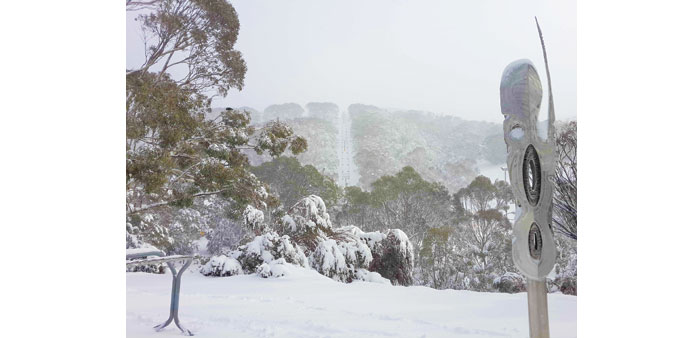SNOW: This file photo depicts the snowfall that Perisher Valley receives in New South Wales, Australia during winters (generally the hottest summer months in Qatar). Photo by Coekon
By Steff Gaulter
Whilst we’re all boiling alive in the giant furnace that is Qatar, it’s hard to remember that some people are wearing their winter coats and fur boots. It may be the height of summer in the northern hemisphere, but in the southern hemisphere it is the middle of winter.
Australia, South Africa, Chile and Argentina are just a few of the countries who are enduring the chilly weather and dark evenings typical of winter. However, often these locations have relatively mild winters; Melbourne has an average high of 14C in July, and Sydney’s is 17C. Although this is obviously an average and the temperature doesn’t always climb this high, it’s a far cry from the northern hemisphere’s winter, where many places stay below freezing for days on end. Toronto in Canada and Sweden’s capital Stockholm are just two of a multitude of cities that have an average maximum temperature in January which is below freezing.
The reason that the winters are often milder in the southern hemisphere is simply down to geography. In the northern hemisphere there is a lot more land near the pole, but in the southern hemisphere there is a huge expanse of sea. This vast sea circles Antarctica and most of the inhabited land is further north than you might think. Sydney and Cape Town are on a latitude of approximately 34 degrees South, but 34 degrees North of the equator is the latitude of Morocco’s Rabat or Los Angeles in the USA. Neither of these places are particularly cold! Even Melbourne, which is further south and has a more variable climate is on a latitude of approximately 38 degrees South, 38 degrees North is the latitude of the sunny Spanish city of Alicante.
Only the small peninsulas of South America and New Zealand jut out into the Southern Ocean, and without significant land for thousands of kilometres, the winds tear around the globe. This vigorous circulation ensures that the majority of the coldest air is trapped to the south, over Antarctica. However, every now and then a blast of frigid air heads north and brings an unwelcome shock to the residents.
Last weekend one of these stray icy blasts from Antarctica brought many parts of Australia a stark reminder that it was winter. The mild conditions were chased out by cold air that rushed in on winds that were gusting up to 98 kph (61 mph). The winds tore down trees and powerlines and the temperatures dropped like a stone. As the winds roared, there was also some rather more unusual weather.
‘Thundersnow’ was seen across many parts of southern and eastern Australia. The name may sounds like a character from the children’s cartoon ‘Thundercats’, but it’s a real weather phenomenon. As its name suggests, thundersnow is simply a thunderstorm that produces snow instead of rain. It’s fairly rare to see snow and lightning together because they generally happen at opposite ends of the temperature spectrum: snow falls in cold air, but thunderstorms largely develop in hot weather.
Thunderstorms are huge towering storms that usually form in hot, humid air. They are generally limited to the warmer times of year because they need a sharp temperature contrast in order to form. However, in this case the temperature contrast between the warm air ahead of the storm and the cold air from Antarctica was sufficient to trigger thunderstorms. What’s more, these thunderstorms developed in air that was cold enough for snow to form.
Thundersnow is unusual, but most of the characteristics of the thunderstorm are the same as a regular rain-generating one. At night, however, the storm can look a little different. In the darkness, the lightning often appears brighter than usual because it is reflected against the brilliant white snowflakes. This generally makes it more picturesque, but not all the features of the storm are enhanced; the snowfall also muffles the thunder, so that it can only be heard up to about 5 kilometres (3 miles) away.
Whether it’s night or day, thundersnow can produce impressive amounts of snow. In Australia, the thundery storms were followed by blizzard conditions, bringing the largest coating of snow to the country in eight years. Overall, snow was seen in three states: South Australia, Victoria and New South Wales. Some of the heaviest of the snow fell in the Central Tablelands, just to the west of Sydney. As the snow mounted up on roads, a number of major access routes were forced to close.
A large build-up of snow can cause major problems and not only to roads. Unlike rain which simply runs off a surface, snow accumulates and this can add a vast amount of weight. In the Central Tablelands, the heavy snow damaged roofs and pulled down a number of trees. However, while some people were lamenting the snow, many more were celebrating it. Hundreds of people from Queensland drove south for hours to see the snow in the neighbouring state of New South Wales. One 63-year-old man said it was the first time he’d ever seen a snow flake. That made me think, there must be many people in Qatar who have never seen snow, which is a shame as it’s one of the most beautiful types of weather.



